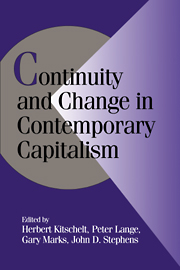Book contents
- Frontmatter
- Contents
- List of Contributors
- Preface
- Introduction
- PART I THE INTERNATIONAL SETTING FOR POLITICAL-ECONOMIC STRATEGIES
- PART II THE DYNAMICS OF DOMESTIC POLITICAL ECONOMIES
- PART III POLITICAL ECONOMY AND DEMOCRATIC COMPETITION
- 10 Politics without Class: Postindustrial Cleavages in Europe and America
- 11 European Social Democracy between Political Economy and Electoral Competition
- 12 Contemporary Christian Democracy and the Demise of the Politics of Mediation
- 13 The Political Economy of Neoliberalism: Britain and the United States in the 1980s
- 14 Movements of the Left, Movements of the Right: Putting the Mobilization of Two New Types of Social Movements into Political Context
- PART IV CONCLUSION
- References
- Index
- Title in the series
11 - European Social Democracy between Political Economy and Electoral Competition
Published online by Cambridge University Press: 05 June 2012
- Frontmatter
- Contents
- List of Contributors
- Preface
- Introduction
- PART I THE INTERNATIONAL SETTING FOR POLITICAL-ECONOMIC STRATEGIES
- PART II THE DYNAMICS OF DOMESTIC POLITICAL ECONOMIES
- PART III POLITICAL ECONOMY AND DEMOCRATIC COMPETITION
- 10 Politics without Class: Postindustrial Cleavages in Europe and America
- 11 European Social Democracy between Political Economy and Electoral Competition
- 12 Contemporary Christian Democracy and the Demise of the Politics of Mediation
- 13 The Political Economy of Neoliberalism: Britain and the United States in the 1980s
- 14 Movements of the Left, Movements of the Right: Putting the Mobilization of Two New Types of Social Movements into Political Context
- PART IV CONCLUSION
- References
- Index
- Title in the series
Summary
In the 1980s and 1990s, social democratic parties have experienced unprecedented difficulties in choosing and implementing economic policies. At the same time, they have found it harder to frame electoral appeals in an increasingly complex environment of party competition. The pressure to make choices in innovative ways, in turn, has generated strains in social democratic party organizations and has affected the loyalty of party members and activists. Explaining the diverse trajectories of European social democratic parties in these decades requires a substantive and a theoretical departure from conventional accounts of social democratic success that worked well for the post–World War II era labeled by some contributions to this volume the “golden age” of social democracy.
In substantive terms, if social democracy has the fundamental objective of moderating wage earners' exposure to market risks (due to sickness, old age, unemployment) and engineering significant income redistribution toward the less fortunate in society, while promoting economic growth, then the strategic opportunities for such policies have dramatically changed since the 1950s and 1960s. In those decades, high postwar economic growth rates, a stable proportion of the population in retirement, national controls over financial markets, and the absence of competition from newly industrializing countries allowed social democrats to expand the welfare state and create full employment while maintaining balanced budgets.
- Type
- Chapter
- Information
- Continuity and Change in Contemporary Capitalism , pp. 317 - 345Publisher: Cambridge University PressPrint publication year: 1999
- 84
- Cited by

